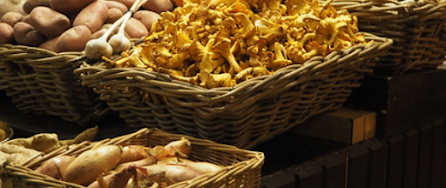from
Behind the French Menu
by
Bryan G. Newman
behindthefrenchmenu@gmail.com

Provençal Daube
Photograph
courtesy of NwongPR
www.flickr.com/photos/nwongpr/51436460197/
The best parts of the chuck are the Basses Côtes
Dining in France on fabulous meat dishes means more than an excellent fillet or an entrecote steak from grass-fed beef served with perfect French fries. French chefs use their knowledge of the tastiest cuts for stews and other dishes. An example is the way the French use part of the cut called chuck in the USA and the UK. Chuck comes from the end of the entrecote, and the rib-eye steaks and in the USA continues towards the neck. In France, the first five ribs of the UK or USA Chuck are the Basses Côtes; these cuts offer the best flavor.
The French Cuts.
Photograph courtesy of
saprimex.fr
Before they graduate from cooking school,
French chefs must be able to buy, choose, cut, and prepare all cuts of meat.
France has no equivalent of the USDA Choice, Select, or Prime, so all French
chefs must learn how to select meat themselves. They look for the required
marbling, know how to eliminate tough cuts, check the thickness covering the
bones, etc. Many French chefs know as much about the different cuts as a
professional butcher does.
A menu list offering a Bœuf Bourguignon or a Provencal Daube will rarely tell you which cut is used, but a French diner will know that the best of these are from the Basses Côtes. The Basses Côtes offer more flavor than any other cut, and most North American and UK chefs agree.

The British Cuts
On your menu in France:
Basse Côte de Boeuf Black Angus, Effeuillée d'Ėpinards, et Pommes Anna - The best part of the chuck from Black Angus beef served with spinach with the stems removed and Anna potatoes. The meat will be cut thinly and marinated overnight, producing a tasty and delicate cut that will be lightly fried. The Basses Cotes make some steaks, but they cannot be cooked more than medium-rare. For more about ordering steaks in France cooked the way you prefer, click here.
Pommes de Terre Anna
Pommes de Terre Anna is sliced potatoes baked in butter in a casserole and is considered a potato dish with an indiscreet past. The chef Adolphe Dugléré, who created this dish, was the Chef de Cuisine at a famous Parisian restaurant called the Café Anglais in the middle of the 19th Century. An important restaurant customer was Anna Deslions, one of Paris’s most famous courtesans; she entertained her wealthy customers in one of the upstairs rooms of the restaurant. Adolphe Dugléré, a pupil of France’s most renowned chef Antonin Carême, named the dish after this important customer.

Anna
potatoes
Photograph courtesy of stu_spivack
www.flickr.com/photos/stuart_spivack/4010845467/
Cœur de Basse Côte de Bœuf aux Baies de Séchouan – The heart of the chuck steak flavored with Sichuan Pepper Berries. Sichuan berries, while not a real pepper, can be as hot as chili. Sichuan pepper is also one of the spices used in Chinese five-spice powder.
Basse Côte de Bœuf, Façon Bourguignonne Revisité - Here the beef is prepared and cooked as Bœuf à la Bourguignonne and “revisite” means revisited. Revisiting on any menu listing indicates that the chef will be making some changes in a traditional recipe. Here it would be interesting if you asked the waiter what the changes are.

Basse
Côte de Bœuf, Façon Bourguignonne
Photograph courtesy of Arnold Gatilao
www.flickr.com/photos/arndog/2414896865/
Basse Côte de Bœuf Black Angus de U.S.A. Sauce Choron – Chuck steak from imported USA Black Angus Beef served with a Sauce Choron. Sauce Choron is a child of Sauce Bearnaise, itself a child of Sauce Hollandaise. Many sauces were developed from Sauce Hollandaise, and that is why it is called a mother Sauce. Sauce Choron is Sauce Béarnaise with added tomatoes.
Basse Côte de Bœuf Grillée Sauce Barbecue au Jack Daniel’s
Jus Vin Rouge et Moelle, Frites - The middle rib from the chuck is served with a sauce made from the natural cooking juices flavored with red wine and bone marrow. French fries will be served on the side. The plancha or planxa is a very thick iron sheet. It is at least two centimeters (6/8") thick and claimed as their own by the Basques, the French, and the Spanish. This traditional cooking method provides very even heat and uses very little oil; the result is a taste somewhere between frying and grilling.

Noix
de Basse-Côte de Bœuf Black Angus
Photograph courtesy of Trip Advisor.
Basse Côtes Farci de Boeuf Braisé aux Trompettes de la Mort - Here a cut from the Basses Cotes is stuffed with wild Black Chanterelle or Black Trumpet mushroom. The first name for this mushroom in French translates as the "Trumpet of Death," though this mushroom is not poisonous; the second name sounds much better and means "Horn of Plenty." This mushroom is mostly called the black trumpet mushroom in English. The Horn of Plenty mushroom is an important member of the Chanterelle mushroom family, which are all wild mushrooms; they will be on the menu in season, which, depending on the area in France, runs from the end of June through September.

Basse
Côte Grillée
L’Atellier des Chefs
Basse Côtes d'Agneau Rôti aux Girolles – A Basses Côtes of lamb roasted with wild Chanterelle Girolle mushrooms. Lamb does not have a cut called chuck in English; nevertheless, the placing of the Basses Côtes is still the cut between the shoulders. The Girolle Chanterelle mushroom on this listing will be gathered in the wild. Most restaurants have yearlong agreements with professional ramasseurs, professional gatherers; all year round, they gather wild mushrooms, herbs, and spices and sell them to restaurants. Despite that, sometimes the chef is a mushroom addict, and it is he or she that is up early for a long walk and search in the woods after the rain.

Wild
Chanterelle/Girolle Mushrooms on sale in the market.
Photograph courtesy of Henry Söderlund
www.flickr.com/photos/hrns/14945340814/
In French supermarkets, as in the USA and the UK, the parts of
the chuck used in France will carry different suffixes. However, the Basses
Cotes cover a smaller area than the USA or UK chuck, and that part of the list
will be much shorter. The Basses Cotes cuts come from marbled meat and make
excellent stews. Thinly sliced and marinated, they can be grilled or fried as
steak; these are neither tough nor fatty cuts.

The USA Cuts
Photograph
courtesy of Beef2Live
--------------------------------
Searching for the meaning of words, names or phrases
on
a French menu?
Just add the word, words, or phrase that you are searching for to the words "Behind the French Menu" (best when including the inverted commas), and search with Google. Behind the French Menu’s links, include hundreds of words, names, and phrases that are seen on French menus. There are over 450 articles that include over 4,000 French dishes with English translations and explanations.
----------
Behind the French Menu
by
Bryan G. Newman
behindthefrenchmenu@gmail.com
Copyright 2010, 2016, 2021
--------------------
Connected Posts:











